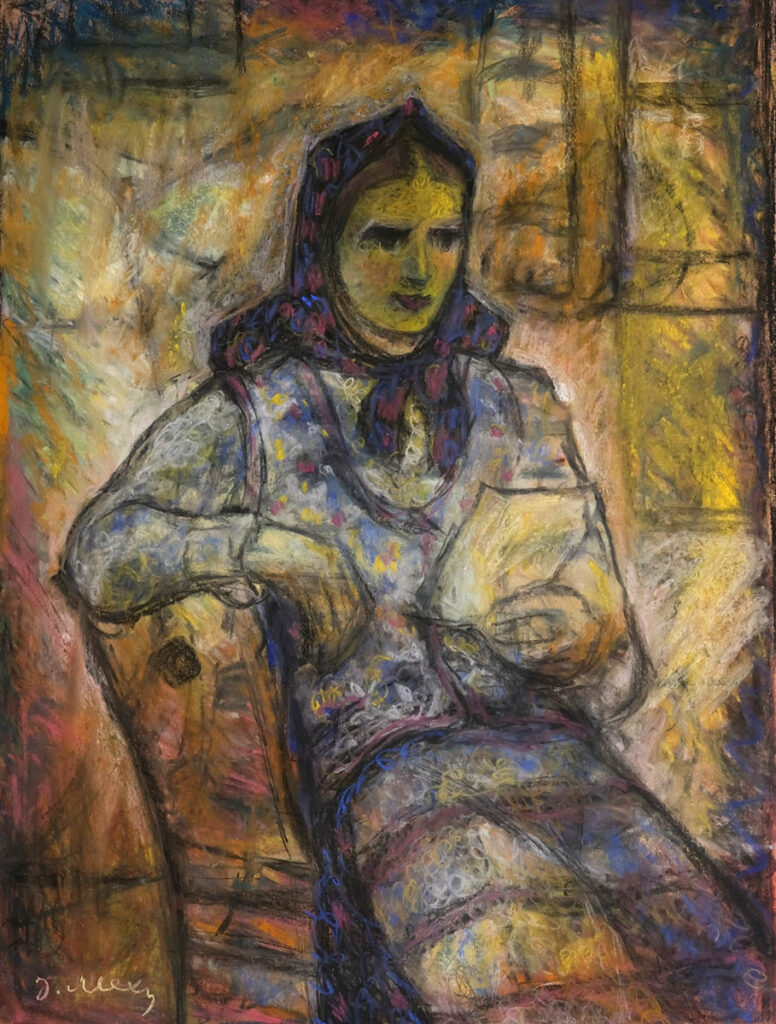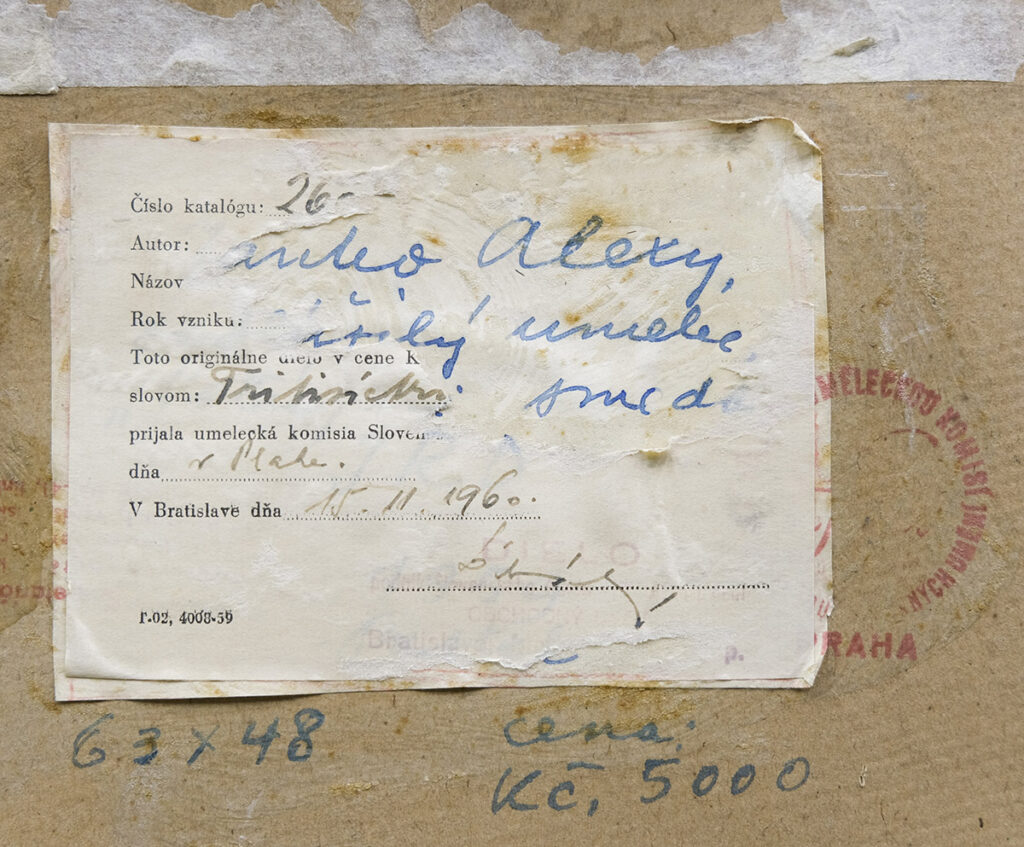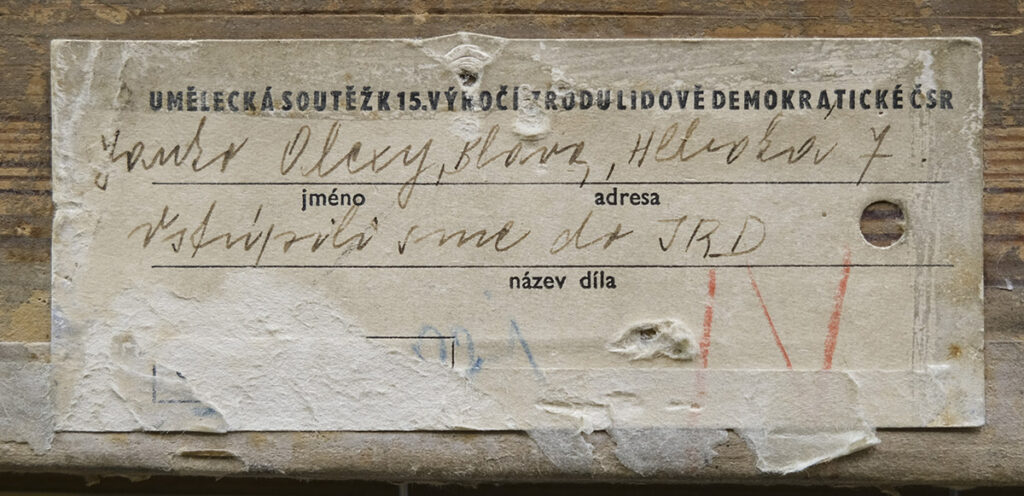Formally, the painting We Have Joined JRD from Nitra Gallery’s collection is a typical Alexy’s portrait from the second half of the 1950s when he returned to his favourite technique of dry pastel. It allowed for the incorporation of a relaxed style and soft “curls” which were put into contrast with the sharper lines of the face and clothes and reduced colour palette in order to achieve a poetic or balladic tone of numerous portraits of motionless sitting figures lost in thought (mostly women) whose static characteristics remind us of still lives.
With a few exceptions, Janko Alexy did not date his works, which is why there are various confusions and mistakes being made today. However, the image in our collection can be confidently assigned to the given period not just because it was when he returned to creating dry pastel portraits in 19541, but also due to the painting’s back side. The back sides of paintings often hold various interesting facts in the form of information labels glued to the frames or writings directly on the canvases. In this case, we have found a label from November 15, 1960, providing information the image was approved by a committee to become a part of the Slovak Fine Art Fund2. Another label written in Czech informs the work participated at a competition held on the occasion of the “15th anniversary of the people’s democratic CSR” [Czechoslovak Republic], which was in 1963. The image was transferred to the Nitra Gallery collection in July 1965 from the Regional Museum of National History in Bojnice. It was one of the first transfers of artworks between institutions operated by the Nitra Region, which was supposed to help with building the collection of the newly established gallery.
The image captures a sitting woman wearing a headscarf with her right hand freely resting on a chair’s backrest and her left one holding a piece of paper she is reading. She is most likely inside, we assume there is a window on the right, but the background is blurred, which is why we cannot say with confidence where the scene takes place. The key to the painting’s interpretation is in its title – “We Have Joined the JRD”.
What the woman is reading could be interpreted as a letter or some other kind of an official written statement about the woman’s or her family’s new affiliation with the Unified Agricultural Cooperatives [Jednotné roľnícke družstvo – JRD]. During the totalitarian communist regime in Czechoslovakia between 1949 – 1990, JRDs were collective farms unifying most of the nation’s agricultural production. The JRD concept started after the communists came to power in the 1948 coup and is related to the regime’s collectivisation which happened in several stages. In many cases, it was a matter of either involuntary or even forceful confiscation of private property, which was often referred to with one of the propaganda euphemisms as “nationalisation”. When someone refused to join a JRD, they could have ended up in prison. Agricultural land was no longer to be owned by individuals, which at that time meant wealthy farmers, landowners (so-called “kulaks”) or the church, but rather by the people. At the beginning, small farmers and peasants would appreciate the change, but it later turned out that by “people” they mostly meant the government and the ruling communist party with its top officials.
During the peak period of socialist realism in Czechoslovakia (1948 – 1956), the motifs of collectivisation of agriculture in art would be depicted optimistically and schematically – farmers with determined smiles and sights set for brighter tomorrows would be giving up their own land voluntarily for the greater good of everyone. In terms of this genre, Alexy’s image is rather unconventional. The depicted woman is not smiling, but she is not frowning either – her expression is somewhat ambivalent. Is she supposed to be evoking a more realistic resignation instead of the ideologically inspired happiness? Alexy’s painting cannot be clearly categorised as an unambiguous criticism of the period’s social order, but it is interesting to see how he had decided to respond to the “compulsory homework” given to official artists. And it is not just in the case of this particular piece. Another painting titled Cooperative Farmers from the collection of the Central Slovak Gallery in Banská Bystrica and dated to the same period captures people sitting at a table with deep-in-thought faces, even frowning expressions. Again, no smiling collaborators, they are even missing the usual attributes of “kolkhoz” members, like sickles, wheat ears, etc. The only connection of the image to JRD is its title, but it might as well have been called “Harvest”, “In a Tavern” or “Villagers”.
Janko Alexy (25. 1. 1894, Liptovský Mikuláš – 22. 9. 1970, Bratislava)
A painter, writer, publicist and cultural life enthusiast. He is one of the founding fathers of Slovak fine art modernism. He was very active at both cultural and social scenes. For example, after the Second World War, he played an important role in the preservation and restoration of the Bratislava Castle. Besides art, he was also active in literature as a critical glossarist of the fine art scene and essayist of Slovak artists’ life stories. He published over 20 books (short stories and novels) which often contain autobiographic and memoir features. Janko Alexy’s large oeuvre consists of around 1 300 oils, pastels, temperas and drawings. His creative program was not homogenous, different techniques and themes can be associated with different periods of his life.
Between 1906 – 1912, he attended a secondary grammar school in Lučenec. After graduation, he tried several jobs – he worked as a trainee chimney-sweeper as well as a trainee pharmacist. Between 1916 – 1917, he studied at the Faculty of Arts in Budapest and during the First World War, between 1917 – 1918, he was a soldier in the Austro-Hungarian army and fought in Russia and Italy. Between 1919 – 1926, he studied at the Academy of Fine Arts in Prague under professors Josef Loukota, Vlaha Bukovac, Max Pirner and Max Švabinský. In 1920, he published an album of drawings titled Pictures of Slovakia he had created during his study trip across Slovakia. He also went on study trips to France (1920, 1936) and Italy (1926). He was a member of the Svojeť association and together with Gejza Vámoš and other students they started publishing a magazine of the same name in 1922. He taught drawing until 1929 when he moved in with Miloš Alexander Bazovský who lived in Turany, and started focusing purely on painting. Between 1930 – 1932, he worked a lot with M. A. Bazovský and Zoltán Palugyay – they would wander across the northern and central parts of Slovakia in search of art material and they would also hold travelling exhibitions. Between 1932 – 1937, he lived in Piešťany where he managed an art colony he hoped would attract the attention of the biggest names in art at that time. However, the project was not a success, so he decided to move permanently to Bratislava in 1937. At this time, his work starts featuring many urban themes – paintings of historical architecture, heritage sites, vistas, secluded urban areas, cafes and famous people. In the 1950s, he designed monumental decorative tapestries and created stained glass windows for architecture (e.g. Pavol Országh Hviezdoslav Theatre in Bratislava, 1952 and the Park of Culture and Relaxation [PKO] in Bratislava, 1957). In 1948, he published novelised biographies of Slovak artists titled Destinies of Slovak Fine Artists. At the end of his life, he returned to rural themes, folk poetics and lyrical landscape. In 1964, on the occasion of his 70th birthday, he was named a National Artist.
— Omar Mirza, April 2023
Notes
1 Veselý: Janko Alexy, 1974, p 95.
2 Which meant it could have been sold in the only official art stores at that time titled Dielo [Artwork].
Bibliography
ABELOVSKÝ, Ján, HANZEL, Bohumil, ed. Janko Alexy. Translated by Eva BREJOVÁ. Trenčín: Q-EX, 2008. Zlatý fond slovenského výtvarného umenia [Slovak Fine Art Golden Fund]. ISBN 9788096959891.
HRONSKÝ, Jozef Cíger. Janko Alexy. Bratislava: Učiteľské vydavateľstvo slovenské [Slovak Educational Publishing] „UNÁS“, 1934. Slovak Artists, sv. 1.
KISS-SZEMÁN, Zsófia – OBUCHOVÁ, Viera – PAŠKO, Peter. Nedbalka Gallery. Slovak Modern Art. Bratislava: Calder s. r. o., 2012, p. 49. Available at: https://www.nedbalka.sk/autori/janko-alexy/ (Accessed on: October 13, 2022).
VESELÝ, Marian. Janko Alexy. Bratislava: Slovak Fine Art Fund, 1967.
Inventory No.: O 43
Artist: Janko Alexy
Title: We Have Joined the JRD
Year of origin: 1955 – 1960
Technique: dry pastel
Material: paper
Dimensions: height 55 cm × width 42,5 cm
Signature: bottom left, white chalk: J. Alexy


